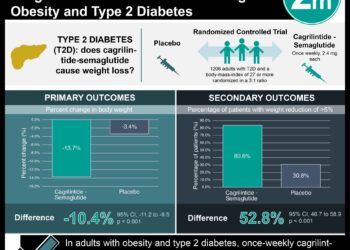Sodium-glucose cotransporter 2 inhibitors may reduce incidence of obstructive airway disease
1. Among patients with type 2 diabetes in Hong Kong, the use of sodium-glucose cotransporter 2 inhibitors (SGLT2i) can reduce the incidence of obstructive airway disease and exacerbations compared to dipeptidyl peptidase-4 inhibitors (DPP4I).
Evidence Rating Level: 2 (Good)
Study Rundown: Chronic obstructive airway disease (OAD) continues to be a leading cause of death among respiratory illnesses. Studies have suggested that individuals with OAD frequently present with diabetes. Sodium-glucose cotransporter 2 inhibitors (SGLT2I) are a new class of antidiabetic medications which have a positive role in the cardiovascular and respiratory systems. As such, some studies indicate that SGLT2Is can influence outcomes in OAD, but there is a scarcity of literature investigating this specific phenomenon in more detail. External literature has also posed an interaction between dipeptidyl peptidase-4 inhibitor (DPP4I) use and a reduction in the incidence of asthma. Currently, no thorough comparisons of SGLT2I and DPP4I in the context of respiratory disease exist. This retrospective cohort study aimed to investigate the association between SGLT2 and DPP4I use with incident OAD among patients with type 2 diabetes in Hong Kong. A total of 30,385 participants with a history of diabetes without a prior history of OAD were included. The primary outcomes of interest were the first incidence of OAD and the frequency of OAD exacerbations. Participants were followed until the occurrence of the study outcome, death, or discontinuation of either medication. The results of this study showed that compared to DPP4I use, SGLT2I use was associated with a decreased risk of incident OAD and lesser frequency of OAD exacerbations. As such, this retrospective cohort study among type 2 diabetic patients in Hong Kong, supports the use of SGLT2I to reduce the risk of incident OAD.
Click here to read this study in JAMA Network Open.
In-Depth [retrospective cohort study]: The present study used data from adult participants in Hong Kong with a diagnosis of type 2 diabetes, who were prescribed either an SGLT2I or DPP4I, with no prior history of OAD and filled prescriptions for any inhalers. Patients using SGLT2I were classified as the exposed group whereas those who started DPP4Is were considered the control group. This cohort was followed until the study’s outcomes occurred, patient death, or till discontinuation of either medication. The primary outcome that was assessed was the first incidence of OAD and the frequency of OAD exacerbations. An OAD exacerbation was defined as an emergency department visit with a diagnosis of OAD or a prescription of a short course of oral corticosteroids. Statistical analyses included a Cox proportional hazards regression model. Several subgroup analyses evaluating the use of SGLT2I and DPP4I use with incident OAD amongst subgroups of men and women, separately were conducted. The results of this study showed that participants belonging to the exposed group who underwent therapy with SGLT2I had a significantly lower risk of developing OAD compared to individuals who used DPP4I. Specifically, SGLT2I was associated with a 35% reduced risk of incident OAD compared to DPP4I use (HR 0.65, 95%CI 0.54-0.79). These associations were similar among both men and women. Additionally, compared to DPP4I use, SGLT2I use was associated with a 46% reduced rate of OAD exacerbations (RR 0.54, 95%CI 0.36-0.83). This study ultimately concludes that among type 2 diabetic patients in Hong Kong, the use of SGLT2I can reduce the incidence of obstructive airway disease and exacerbations compared to patients using DPP4I. This study is the first of its kind to examine and observe this relationship as external literature on this subject remains scarce. As type 2 diabetes is strongly associated with the development of obstructive airway disease, the trialing of antidiabetic agents which offer protective effects for OAD is very clinically important. However, there are several limitations in this study that should additionally be noted. Firstly, as this study was conducted only in Hong Kong, its generalizability to the broader population is limited. As well, the observational nature of this study limits the derivation of conclusive evidence to support clinical practice. Nevertheless, this paper does warrant further randomized clinical trials investigating SGLT2I in the context of OAD to provide more elaborate management suggestions.
Image: PD
©2023 2 Minute Medicine, Inc. All rights reserved. No works may be reproduced without expressed written consent from 2 Minute Medicine, Inc. Inquire about licensing here. No article should be construed as medical advice and is not intended as such by the authors or by 2 Minute Medicine, Inc.






